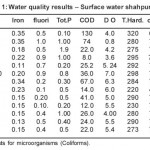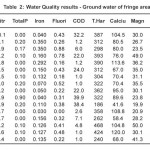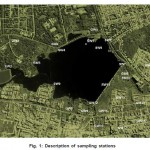Physico-Chemical Studies of Water Quality of Shahpura Lake, Bhopal (M.P) with Special Reference to Pollution Effects on Ground Water of its Fringe Areas
Trivedi Sonal1 * and H. C. Kataria1
1
Department of Chemistry,
Government Geetanjali Girls PG (Autonomus) College,
Bhopal
India
DOI: http://dx.doi.org/10.12944/CWE.7.1.21
Indiscriminate and wasteful water consumption and improper waste disposal practices have led to deterioration in the water quality be it surface or ground water. Shahpura is an in-land urban surface water body which is fed by Bhopal city waste water and effluent from adjoining Shahpura and Chunabhatti townships thereby converted into a polluted lake. This is a maiden attempt to highlight the spread of polluted surface water into the ground water aquifer which is supports the drinking water supplies to a large population of Bhopal.
Copy the following to cite this article:
Sonal T, Kataria HC. Physico-Chemical Studies of Water Quality of Shahpura Lake , Bhopal (M.P) with Special Reference to Pollution Effects on Ground Water of its Fringe Areas. Curr World Environ 2012;7(1):139-144 DOI:http://dx.doi.org/10.12944/CWE.7.1.21
Copy the following to cite this URL:
Sonal T, Kataria HC. Physico-Chemical Studies of Water Quality of Shahpura Lake , Bhopal (M.P) with Special Reference to Pollution Effects on Ground Water of its Fringe Areas. Curr World Environ 2012;7(1):139-144. Available from: http://cwejournal.org?p=366/
Download article (pdf)
Citation Manager
Publish History
Select type of program for download
| Endnote EndNote format (Mac & Win) | |
| Reference Manager Ris format (Win only) | |
| Procite Ris format (Win only) | |
| Medlars Format | |
| RefWorks Format RefWorks format (Mac & Win) | |
| BibTex Format BibTex format (Mac & Win) |
Article Publishing History
| Received: | 2012-03-15 |
|---|---|
| Accepted: | 2012-04-15 |
Introduction
Fresh Water is essential to existence of life. Water of acceptable quality is essential not only for drinking and domestic purposes but also for agriculture, industrial and commercial uses. Surface water is collection of water on the ground or in a stream, river, lake, wetland, or ocean. Surface water is naturally replenished by precipitation and naturally lost through discharge to evaporation and sub-surface seepage into the groundwater. A lake is a large body of water surrounded by land and inhabited by various aquatic life forms. Lakes are subjected to various natural processes taking place in the environment, such as the hydrological cycle. Due to tremendous population growth of the city (from just over 0.1million in 1951 to about 1.8 millions in 2007) and rapid urban development, lakes are facing various environmental problems resulting in deterioration of its water quality. The area of the study selected, to estimate the water quality and levels of water pollution, is the Shahpura lake of Bhopal city. It is located in the southern part of the city. It is manmade reservoir formed in 1974-75, under the Betwa irrigation project. The waste water inflow keeps the lake perennial and the over flowing water flows through a nala to join kaliyasot river which flows into river Betwa. Various physico-chemical parameters were studied to assess the water quality status and the extent of deterioration in the water quality of lake. The degradation of lake has occurred not only due to waste water effluent inflow but also by saltation, domestic sewage, immersion of idols and other activities around the lake. Thus the lake is subjected to enormous anthropogenic stress; the overall impact has resulted in the deterioration of the water quality, accumulation of toxic chemicals and sediments, shrinkage of lake area and above all, loss of the aesthetic value. It is well known that hydrologic environment is composed of two interrelated phases; ground water and surface water. Impacts initiated in one phase eventually affect the other system. The polluted lake water may enter into aquifer or ground water body of fringe areas, specially the downstream areas by percolation and influent seepage. The natural quality of hand pumps, bore wells and drinking water resources tend to be degraded in the fringe areas of lake. Several investigations and research studies have been made on water quality and increasing pollution level of the water body. They all indicate the alarming contamination of the lake which is very high as compared to the standard guidelines, revealing that nutrient load in the lake is very high and hypereutrophic conditions are prevailing. Hence periodic monitoring and preventive measures are required to save the lake from eutrophication. Although, few work has been done to understand the status of the lake, no study has been made on the pollution effects of the lake on the ground water quality of the adjoining areas. The polluted lake water may enter into aquifer or ground water body of fringe areas specially the downstream areas by percolation and influent seepage. At least sixty thousand population resides in the fringe area and is dependent on the ground water, moreover the Chunabhatti area acts as a ground water sanctuary for the town as the drinking water is supplied to the different parts of the city through the water tankers filled from the tube wells daily. Therefore the assessment and monitoring of its water quality is very important. Hence a serious need is felt for the study of the water quality which could prove beneficial for the large number of people.
Methods
To study the water quality status of Shahpura lake, thirteen surface water quality monitoring stations were chosen at different points of the lake and sixteen ground water quality monitoring stations in the fringe area (where source water is mainly ground water) were finalized. The methods of water analysis were used as prescribed by APHA (American Public Health Association) water environment federation and National Environment Engineering Research Institute (NEERI), Nagpur. Water samples were collected during the winter season, 2011 from the selected stations. The analysis of the following physico-chemical parameters was carried out: pH, Electrical Conductivity(EC - µmho/ cm), Total Dissolved Solids(TDS - mg/L), Ammonia (mgNH3-N/L), Nitrate (mgN/l), Total Phosphorus (mgP/L), Iron (mg/L), Fluoride (mg/L), Chemical Oxygen Demand (COD - mg/L), Dissolved Oxygen (DO – mg/L ), Total Hardness (T.Hard. - mgCaCO3/ L), Calcium (mg/L), Magnesium (mg/L), Chloride (mg/L), Sulphate(mg/L), Carbonate (mg/L), Bicarbonate (mg/L) and Coliforms.
Results and Discussion
The physico-chemical data collected from different sampling stations Table 1 and 2.
 |
Table 1: Water quality results – Surface water shahpura lake Click here to View table |
 |
Table 2: Water Quality results - Ground water of fringe area Click here to View table |
 |
Figure 1: Description of sampling stations Click here to View figure |
| Sampling stations - Surface water of Shahpura lake | ||
| S.NO | Sampling | Location |
| station | ||
| 1 | SW1 | Main untreated kotra drainage(Source water ,upstream of lake) |
| 2 | SW2 | Confluence point of drainage nalla from charimli area behind PCB |
| 3 | SW3 | Near Dhobighaat behind PCB(high algal growth) |
| 4 | SW4 | Near slum area Infront of academy of administration(slum area) |
| 5 | SW5 | Near Shahpura park |
| 6 | SW6 | Confluence of shahpura sewage nala |
| 7 | SW7 | Near Waste weir(outlet) |
| 8 | SW8 | The shahpura lake(near fishing point) |
| 9 | SW9 | Near amrapali Residential colony |
| 10 | SW10 | Near hanuman temple (downstream of waste weir) |
| 11 | SW11 | Near Earthen bund(Downstream of lake) |
| 12 | SW12 | Earthern dam(near Sluice gate) |
| 13 | SW13 | Waste weir Nalla downstream of lake ,near canal |
Sampling stations - fringe areas of the Shahpura lake
| 1 | GW1 | Tubewell of BSNL premises (upstream of lake) |
| 2 | GW2 | Tubewell of NCHSE premises (upstream of lake) |
| 3 | GW3 | Behind PCB (upstream of lake) |
| 4 | GW4 | Building upstream catchment area (eastern side of lake) |
| 5 | GW5 | Tubewell of rainbow treat restaurant, MP tourism, Manisha market |
| 6 | GW6 | Shallow dugwell (near waste weir, downstream of earthen dam) |
| 7 | GW7 | Tubewell, C- sector, shahpura |
| 8 | GW8 | Tubewell, Kashish restaurant, Kolar road |
| 9 | GW9 | Sardarji Tube well, chunna bhatti (100m from SW-11) |
| 10 | GW10 | Dugwell , Jugal kishore, chuna bhatti village |
| 11 | GW11 | Tubewell, Jugal kishore, Chunabhatti village |
| 12 | GW12 | Tubewell,aranyawali colony ,800m from SW-11(fringe area) |
| 13 | GW13 | Tube well amaltas phase I(100m from SW-12)downstream |
| 14 | GW14 | Tubewell,amaltas phase I-(250m from SW-12)downstream |
| 15 | GW15 | Tubewell amaltas phase II (500m fromSW-11)fringe area |
| 16 | GW16 | Tubewell,,new friends colony(near canal ,,chunabhattt II) |
pH
pH range of 6.5 to 8.5 is normally accepted as per guideline suggested by WHO. In this study pH values were found in the range of 7.5 to 8.5 in the water samples. This shows that pH was observed to be slightly alkaline. Higher pH favors the fish production in reservoir. Electrical conductivity- Higher the concentration of acid, base and salts in water, a higher will be the EC. In this study the value of EC was found above the maximum permissible limit of 500µmho/cm, in drinking waters as recommended by WHO. Total dissolved solids it is an important parameter in drinking water quality standard. It develops a particular taste to the water and at higher concentration reduces its potability Water with more than 500mg/l TDS usually has a disagreeably strong taste. High TDS levels generally indicate hard water, which can cause scale buildup in pipes, valves and filters. Similar high TDS values were found in ground water layers of Bhanpur, Bhopal by Manisha Sonel et al.TDS values in all the samples was found above the WHO permissible limit of 200mg/l .It can be concluded that water is hard at these locations, which necessitates the softening of water prior to its use. In this study The groundwater samples have shown higher values of hardness. Dissolved oxygen and COD-maximum permissible limit for DO as per WHO is 4.6-6.0mg/l it was found within the admissible limit in all the water samples. In the present study high COD values were found which depicts the pollution of water source due to pollutants of organic origin. Nitrate and Phosphate. The world health organization(WHO) has recommended the limit of 10mg/l nitrate nitrogen(NO3-N) for drinking water which is equivalent to about 45mg/l of nitrate (N03)and the same is also accepted in India by the ICMR In a previous study, by Dixit S., et al., the lake was found to be highly eutrophic. The Phosphate content of the lake water studied was found in the range of 6.05 to 9.21 ppm. The Nitrate content of the water was found in the range 2.02 to 15.22ppm. Sharp rise in nitrate content was found from 2003 to 2004, showing the increasing anthropogenic influence on the lake. The raw sewage is the source of nitrates and phosphates in the water. The United States Public Health Standards limit for phosphates in drinking water is 0.1ppm(De,2002,p.p231-232). The phosphate content in the lake water is alarming and very high as compared to the standard guidelines, which reveals that nutrient load in the lake is very high and hypereutrophic conditions are prevailing Fluoride, Chloride and Sulphate. The value of 0.8 to1.0mg/l of F has been recommended by WHO (1970.) Values in all the sample was found in the permissible range. It was observed that the chloride and sulphate concentration in all the samples collected was below the recommended concentration of 250mg/l and150mg/l respectively.
Conclusion
In general the surface water of shahpura lake has shown lesser values of the parameters pH, total hardness, EC, TDS in comparison to the groundwater samples. However, the nitrates and microorganisms (coliform bacteria) showed very high values in lake water. Studies carried out in present investigation revealed that one of the most important causes of water pollution is unplanned urban development without adequate attention to suitable management of sewage and waste material. It is summarized that propagation of pollution front in groundwater aquifer of the fringe area of Shahpura Lake is governed by the hydraulic gradient enhancing influent seepage from Shahpura Lake. The alarm bell therefore rings at the doorstep with the fear of polluting the ChunaBhatti groundwater sanctuary which supports tens of hundreds of water takers from the tube wells of the fringe area of Shahpura lake for water supply in different parts of Bhopal city. Also the entire population of ChunaBhatti Township depends on the water supply from Tubewells/ Borewells. It is therefore, recommended that this groundwater supply from Tube wells should be used as drinking water only after pre-treatment. It may also not be out of context that all the in-lets of city effluents/waste water should be suitably treated before flowing into Shahpura lake.
Acknowledgement
I am grateful and indebted to chemists of Ground water survey, water quality Laboratory, Kolar road, Bhopal for providing lab facilities and guidance time to time.
References
- Adholia,U.N., Studies on hydrology of river Betwa and its fishery resources. PhD Thesis,vikram university, Ujjain (1981).
- APHA.Standard method for examination of water and waste water American public health association, Washington.D.C. (1989)
- Dixit.S and Tiwari.S. Impact assessment of Heavy metal pollution of Shahpura lake, Bioline international-International Journal of Environmental research, university of Tehran, 2(1): 37-42 (2008).
- Dixit Savita, Gupta S.K, Tiwari Suchi.,Nutrient overloading of fresh water lake of Bpl. India., EGJ-Electronic green Journal, 1(21) UCLA Library, UC Los Angeles (2005).
- Dhote Savita. Role of macrophytes in improving water quality of an aquatic ecosystem,shahpura lake,Bpl. J. Applied. Science. Envion. Manageme. 2(4):133-135 (2005)
- Jain.S.K,et al ,Assessment of quality of ground water pollution arising from various sources. Journal of Indian water resources society. 28(3): 9-13 (2008).
- Handa . B . K . W a t e r , G r o u n d w a t e r contamination in India,. National workshop on Environmental aspects of groundwater development, Kurukshetra, India., (1994).
- Kataria,H.C.et al., Studies of water quality of Dahod dam, India, Poll Res.,25(3): 553-556 (2006).
- Kataria,H.C., A biochemical analysis of drinking water of Raisen district (M.P). Asian. J. Chem. Revs. 5(1-2): 66-68 (1994).
- Kudesia V.P. Water pollution, Pragati prakashan, Meerut, (1995).
- Lunkad.s.k,Kurukshetra university,Rising nitrite levels in ground water and increasing N-fertilizer consumption,BHU-JAL news, journal of CGWB, 9(1): 4-10 (1994).
- Manisha Sonel,et al ,Physico-chemical and bacteriological studies of ground water layers in Bhanpur, Bhopal(M.P).,Current World Environment, 5(2): 379-382 (2010)
- Nayar Renu and Tiwari Deepak. Studies on the physico-chemical characteristics of ground water of korba. Current world Environment.J., 3(1): 175-180(2008)
- NEERI, Manual on water and waste water analysis. National Environmental Engineering Resources Institute, Nagpur. 340 (1986).
- Savita Dixit and suchi Tiwari,Effect of religious practices on water quality of Shahpura Lake, M.P, India, Water International., 32(1): 889-893 (2007) Available online-24 feb 2011.
- Anoop-Chandra, P.N. Saxena, Sayeida Ghazala Imam and Geetesh Chandra, Orient. J. Chem. 27(3): 1193-1198 (2011).
- Abdul Rahim and Syed Hussain, Orient. J. Chem. 27(3): 1273-1275 (2011).






